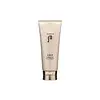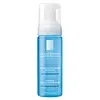What's inside
What's inside
 Key Ingredients
Key Ingredients

No key ingredients
 Benefits
Benefits

 Concerns
Concerns

 Ingredients Side-by-side
Ingredients Side-by-side

Glycerin
HumectantPotassium Cocoyl Glycinate
Water
Skin ConditioningSodium PCA
HumectantCitric Acid
Buffering1,2-Hexanediol
Skin ConditioningHydroxypropyl Starch Phosphate
PPG-3 Caprylyl Ether
SolventOlea Europaea Fruit Oil
MaskingCoco-Betaine
CleansingGlyceryl Stearate
EmollientGlycol Distearate
EmollientPanthenol
Skin ConditioningDisodium Cocoyl Glutamate
CleansingPolyquaternium-7
Sodium Chloride
MaskingSodium Cocoyl Glutamate
CleansingTrisodium EDTA
Butylene Glycol
HumectantGluconolactone
Skin ConditioningSodium Pyruvate
Skin ConditioningSerine
MaskingArginine
MaskingAllantoin
Skin ConditioningGanoderma Lucidum Extract
Skin ProtectingCnidium Monnieri Fruit Extract
HumectantEvodia Rutaecarpa Fruit Extract
Skin ConditioningLysimachia Foenum-Graecum Extract
Skin ConditioningThymus Vulgaris Leaf Extract
Skin ProtectingTocopherol
AntioxidantPanax Ginseng Root Extract
EmollientProtease
ExfoliatingChrysanthellum Indicum Extract
Skin ConditioningLonicera Japonica Flower Extract
Skin ConditioningDioscorea Japonica Root Extract
Skin ConditioningLycium Chinense Fruit Extract
AntioxidantPolygonatum Officinale Rhizome/Root Extract
Skin ConditioningCornus Officinalis Fruit Extract
Skin ConditioningDimocarpus Longan Fruit Extract
Skin ConditioningLitchi Chinensis Fruit Extract
Skin ConditioningMorus Alba Fruit Extract
AntioxidantSchisandra Chinensis Fruit Extract
Skin ConditioningZiziphus Jujuba Fruit Extract
Skin ConditioningPunica Granatum Fruit Extract
AntioxidantAngelica Gigas Root Extract
Skin ConditioningAngelica Tenuissima Root Extract
Skin ConditioningAtractylodes Japonica Rhizome Extract
Skin ConditioningCnidium Officinale Root Extract
Skin ConditioningCuscuta Australis Seed Extract
Skin ConditioningCyperus Rotundus Root Extract
Skin ConditioningGardenia Florida Fruit Extract
Skin ConditioningGlycine Soja Seed Extract
Skin ConditioningLedebouriella Divaricata Root Extract
Skin ConditioningOphiopogon Japonicus Root Extract
Skin ConditioningOyster Shell Extract
Paeonia Suffruticosa Root Extract
Skin ProtectingPoria Cocos Sclerotium Extract
AstringentPrunus Armeniaca Kernel Extract
Skin ConditioningRehmannia Chinensis Root Extract
Skin ConditioningSesamum Indicum Seed Extract
Skin ConditioningTrichosanthes Kirilowii Root Extract
Skin ProtectingViscum Album Extract
Skin ConditioningSodium Benzoate
MaskingParfum
MaskingBenzyl Benzoate
AntimicrobialHydroxycitronellal
PerfumingGeraniol
PerfumingLimonene
PerfumingHexyl Cinnamal
PerfumingCitronellol
PerfumingGlycerin, Potassium Cocoyl Glycinate, Water, Sodium PCA, Citric Acid, 1,2-Hexanediol, Hydroxypropyl Starch Phosphate, PPG-3 Caprylyl Ether, Olea Europaea Fruit Oil, Coco-Betaine, Glyceryl Stearate, Glycol Distearate, Panthenol, Disodium Cocoyl Glutamate, Polyquaternium-7, Sodium Chloride, Sodium Cocoyl Glutamate, Trisodium EDTA, Butylene Glycol, Gluconolactone, Sodium Pyruvate, Serine, Arginine, Allantoin, Ganoderma Lucidum Extract, Cnidium Monnieri Fruit Extract, Evodia Rutaecarpa Fruit Extract, Lysimachia Foenum-Graecum Extract, Thymus Vulgaris Leaf Extract, Tocopherol, Panax Ginseng Root Extract, Protease, Chrysanthellum Indicum Extract, Lonicera Japonica Flower Extract, Dioscorea Japonica Root Extract, Lycium Chinense Fruit Extract, Polygonatum Officinale Rhizome/Root Extract, Cornus Officinalis Fruit Extract, Dimocarpus Longan Fruit Extract, Litchi Chinensis Fruit Extract, Morus Alba Fruit Extract, Schisandra Chinensis Fruit Extract, Ziziphus Jujuba Fruit Extract, Punica Granatum Fruit Extract, Angelica Gigas Root Extract, Angelica Tenuissima Root Extract, Atractylodes Japonica Rhizome Extract, Cnidium Officinale Root Extract, Cuscuta Australis Seed Extract, Cyperus Rotundus Root Extract, Gardenia Florida Fruit Extract, Glycine Soja Seed Extract, Ledebouriella Divaricata Root Extract, Ophiopogon Japonicus Root Extract, Oyster Shell Extract, Paeonia Suffruticosa Root Extract, Poria Cocos Sclerotium Extract, Prunus Armeniaca Kernel Extract, Rehmannia Chinensis Root Extract, Sesamum Indicum Seed Extract, Trichosanthes Kirilowii Root Extract, Viscum Album Extract, Sodium Benzoate, Parfum, Benzyl Benzoate, Hydroxycitronellal, Geraniol, Limonene, Hexyl Cinnamal, Citronellol
 Reviews
Reviews

Ingredients Explained
These ingredients are found in both products.
Ingredients higher up in an ingredient list are typically present in a larger amount.
Citric Acid is an alpha hydroxy acid (AHA) naturally found in citrus fruits like oranges, lemons, and limes.
Like other AHAs, citric acid can exfoliate skin by breaking down the bonds that hold dead skin cells together. This helps reveal smoother and brighter skin underneath.
However, this exfoliating effect only happens at high concentrations (20%) which can be hard to find in cosmetic products.
Due to this, citric acid is usually included in small amounts as a pH adjuster. This helps keep products slightly more acidic and compatible with skin's natural pH.
In skincare formulas, citric acid can:
While it can provide some skin benefits, research shows lactic acid and glycolic acid are generally more effective and less irritating exfoliants.
Most citric acid used in skincare today is made by fermenting sugars (usually from molasses). This synthetic version is identical to the natural citrus form but easier to stabilize and use in formulations.
Read more about some other popular AHA's here:
Learn more about Citric AcidCoco-Betaine is the natural version of Cocamidopropyl Betaine. It is often derived from coconuts.
Coco-Betaine is a surfactant, meaning it helps remove dirt and oil from the skin.
Glycerin is already naturally found in your skin. It helps moisturize and protect your skin.
A study from 2016 found glycerin to be more effective as a humectant than AHAs and hyaluronic acid.
As a humectant, it helps the skin stay hydrated by pulling moisture to your skin. The low molecular weight of glycerin allows it to pull moisture into the deeper layers of your skin.
Hydrated skin improves your skin barrier; Your skin barrier helps protect against irritants and bacteria.
Glycerin has also been found to have antimicrobial and antiviral properties. Due to these properties, glycerin is often used in wound and burn treatments.
In cosmetics, glycerin is usually derived from plants such as soybean or palm. However, it can also be sourced from animals, such as tallow or animal fat.
This ingredient is organic, colorless, odorless, and non-toxic.
Glycerin is the name for this ingredient in American English. British English uses Glycerol/Glycerine.
Learn more about GlycerinParfum is a catch-all term for an ingredient or more that is used to give a scent to products.
Also called "fragrance", this ingredient can be a blend of hundreds of chemicals or plant oils. This means every product with "fragrance" or "parfum" in the ingredients list is a different mixture.
For instance, Habanolide is a proprietary trade name for a specific aroma chemical. When used as a fragrance ingredient in cosmetics, most aroma chemicals fall under the broad labeling category of “FRAGRANCE” or “PARFUM” according to EU and US regulations.
The term 'parfum' or 'fragrance' is not regulated in many countries. In many cases, it is up to the brand to define this term.
For instance, many brands choose to label themselves as "fragrance-free" because they are not using synthetic fragrances. However, their products may still contain ingredients such as essential oils that are considered a fragrance by INCI standards.
One example is Calendula flower extract. Calendula is an essential oil that still imparts a scent or 'fragrance'.
Depending on the blend, the ingredients in the mixture can cause allergies and sensitivities on the skin. Some ingredients that are known EU allergens include linalool and citronellol.
Parfum can also be used to mask or cover an unpleasant scent.
The bottom line is: not all fragrances/parfum/ingredients are created equally. If you are worried about fragrances, we recommend taking a closer look at an ingredient. And of course, we always recommend speaking with a professional.
Learn more about ParfumChances are, you eat sodium chloride every day. Sodium Chloride is also known as table salt.
This ingredient has many purposes in skincare: thickener, emulsifier, and exfoliator.
You'll most likely find this ingredient in cleansers where it is used to create a gel-like texture. As an emulsifier, it also prevents ingredients from separating.
There is much debate on whether this ingredient is comedogenic. The short answer - comedogenic ratings don't tell the whole story. Learn more about comegodenic ratings here.
The concensus about this ingredient causing acne seems to be divided. Research is needed to understand if this ingredient does cause acne.
Scrubs may use salt as the primary exfoliating ingredient.
Learn more about Sodium ChlorideWater. It's the most common cosmetic ingredient of all. You'll usually see it at the top of ingredient lists, meaning that it makes up the largest part of the product.
So why is it so popular? Water most often acts as a solvent - this means that it helps dissolve other ingredients into the formulation.
You'll also recognize water as that liquid we all need to stay alive. If you see this, drink a glass of water. Stay hydrated!
Learn more about Water